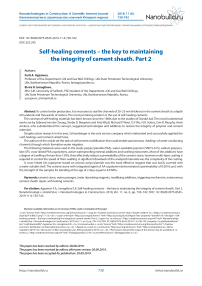Self-healing cements – the key to maintaining the integrity of cement sheath. Part 2
Автор: Agzamov F.A., Ismagilova E.R.
Журнал: Nanotechnologies in Construction: A Scientific Internet-Journal @nanobuild-en
Рубрика: Cement and other binders with mineral and organic additives
Статья в выпуске: 6 Vol.11, 2019 года.
Бесплатный доступ
To control water production, it is necessary to seal the channels of 20–25 mm thickness in the cement sheath at a depth of hundreds and thousands of meters. The most promising solution is the use of self-healing cements. The concept of self-healing materials has been known since the 1980s due to the studies of Donald Jud. The most fundamental works are by Sybrand van der Zwaag, Sheba D. Bergman and Fred Wudl, Richard P. Wool, D.Y Wu, N.R. Sottos, Erin B. Murphy, Henk Jonkers, who substantiated the concept, suggested technologies and additives to restore the integrity of polymer and cement materials. Despite active research in this area, Schlumberger is the only service company which elaborated and successfully applied the «self-healing» well cement called Futur. The authors of the article set the task of well cement modification that could enable autonomous «healing» of water-conducting channels through which formation water migrates. The following materials were used in the study: polyacrylamide (PAA), water-swellable polymer (VNP V-615), sodium polyacrylate (SP), cross-linked PAA copolymers, active waterproofing mineral additives and swelling elastomers. Most of the additives have a degree of swelling of more than 150%, they effectively reduce a permeability of the cement stone, however multi-layer coating is required to control the speed of their swelling. A significant drawback of the analyzed materials was the complexity of the coating. A cross-linked AA copolymer based on anionic polycrylamide was the most effective reagent that was easily covered with a water-soluble shell. The cement stone with integrated agent of AA copolymer demonstrated a permeability of 0.0018 μm2 with the strength of the samples for bending at the age of 2 days equal to 8.0 MPa.
Cement stone, water passages, water absorbing reagents, modifying additives, triggering mechanism, autonomous cement sheath repair, self-healing cements
Короткий адрес: https://sciup.org/142227451
IDR: 142227451 | УДК: 622.245 | DOI: 10.15828/2075-8545-2019-11-6-730-742
Текст научной статьи Self-healing cements – the key to maintaining the integrity of cement sheath. Part 2
Machine-readable information on CC-licenses (HTML-code) in metadata of the paper
Self-healing cements – the key to maintaining the integrity of cement sheath. Part 2. by Agzamov F.A., Ismagilova E.R. is licensed under a Creative Commons Attribution 4.0 International License.
Based on a work at .
Permissions beyond the scope of this license may be available at .
The paper has been received by editors: 28.08.2019.
The paper has been received by editors after peer-review: 20.09.2019.
The paper has been accepted for publication: 29.09.2019.
CEMENT AND OTHER BINDERS WITH MINERAL AND ORGANIC ADDITIVES • ЦЕМЕНТНЫЕ И ДРУГИЕ ВЯЖУЩИЕ С МИНЕРАЛЬНЫМИ И ОРГАНИЧЕСКИМИ ДОБАВКАМИ
Самозалечивающиеся цементы – ключ к сохранению герметичности крепи скважин. Часть 2
Авторы:
Агзамов Фарит Акрамович, профессор кафедры «Бурение нефтяных и газовых скважин» ФГБОУ ВО «УГНТУ»;
Машиночитаемая информация о CC-лицензиях (HTML-код) в метаданных статьи
Self-healing cements – the key to maintaining the integrity of cement sheath. Part 2. by Agzamov F.A., Ismagilova E.R. is licensed under a Creative Commons Attribution 4.0 International License.
Based on a work at .
Permissions beyond the scope of this license may be available at .
Статья принята к публикации: 29.09.2019.
CEMENT AND OTHER BINDERS WITH MINERAL AND ORGANIC ADDITIVES • ЦЕМЕНТНЫЕ И ДРУГИЕ ВЯЖУЩИЕ С МИНЕРАЛЬНЫМИ И ОРГАНИЧЕСКИМИ ДОБАВКАМИ
THE EXPERIMENTAL PART
Methodology of the experimental research
T he physical and mechanical properties of the modifying additives, cement slurry and cement stone made of the modified cement were determined, with a water-cement ratio of 0.5 using standard equipment in accordance with the State Standards GOST 1581-96 and GOST 310.1.96. The granulometric analysis of the components was carried out applying the standard method of sieve analysis.
The swelling kinetics was evaluated with a device for swelling kinetics determination called PKN-2. The degree of the polymer swelling was identified through its mass expression, %:
M = (m–m0)/m0 • 100,
-
m –weight of swollen polymer;
-
m0 – initial polymer weight.
The permeability of the cement stone was defined using the equipment called OFITE MODEL 90 Cement Permeameter.
The tensile strength of the cement stone for bending and compression was measured at the age of 2 days with a universal testing machine MATEST.
There is a phenomenon of mechanical activation – the acquisition of high rheological activity due to deformation of self-stressing microdefects – all along of which the water absorption rate of the crushed modifying additives increases tremendously [27]. In order to enhance the modifying additives activity, they were subjected to additional grinding in a laboratory disintegrator at collision velocity of 150 m/s.
The results of experimental studies
We made samples of modifying additives to test the possibility of polyacrylamide (PAA) usage as a water-swellable component. The sample was composed of a PAA core and a silicone polymer shell.
Evaluation of the swelling kinetics (Fig. 1) demonstrates: the additives started to swell in 2 hours after the interaction with water, and the swelling proceeded within 7 hours with a maximum increase in volume of up to 150% comparing with the initial volume of the additive.
While studying the permeability of “self-healing” cement samples containing 1% modifying additive based on PAA at WCR = 0.5, the sample received through defects, and broke into pieces.
When testing the sample for bending at the age of 2 days, the results did not exceed 3.3 MPa. Figure 2 shows a snapshot of the sample, at the break of which the gel-like PAA fibers are visualized, the entire sample is covered with slime, while the stone has a heterogeneous structure, besides medium sized cavities can be seen.
Furthermore, difficulties in coating the PAA powder arose due to PAA size and the impossibility of its granulation. Moreover, the PAA active water absorption requires a multilayer shell.
Testing of water-swellable polymer (WSP) for the first ten hours of swelling given by the swelling degree at 144% of the initial volume, for the first day the swelling degree was equal to 174%, and for 4 days – 321%, then the stabilization phase began (Fig. 3).
Samples made of cement modified with additive of WSP (1%) had permeability of 0,002 µm2.
The strength of the samples at the age of 2 days in water and 5 days on air was equal to 7.4 MPa. Figure 4 shows a snapshot of a sample at which a bending load
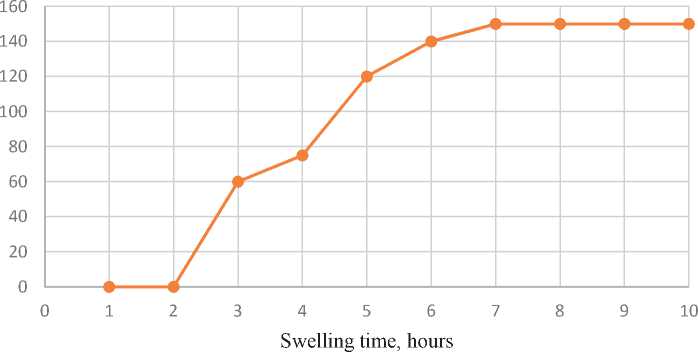
Fig. 1. Dynamics of PAA swelling
CEMENT AND OTHER BINDERS WITH MINERAL AND ORGANIC ADDITIVES • ЦЕМЕНТНЫЕ И ДРУГИЕ ВЯЖУЩИЕ С МИНЕРАЛЬНЫМИ И ОРГАНИЧЕСКИМИ ДОБАВКАМИ
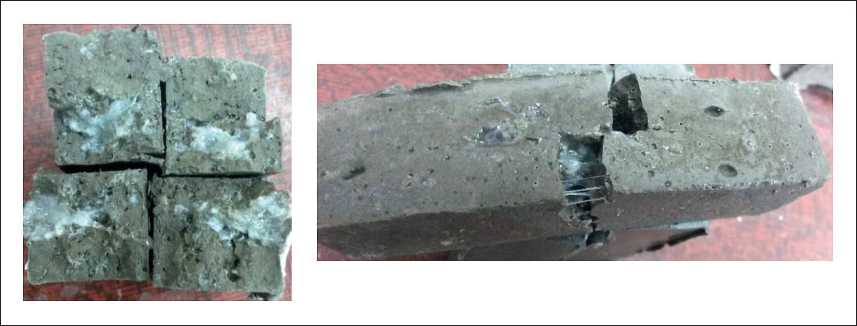
Fig. 2. Samples of cement stone containing PAA (1%)
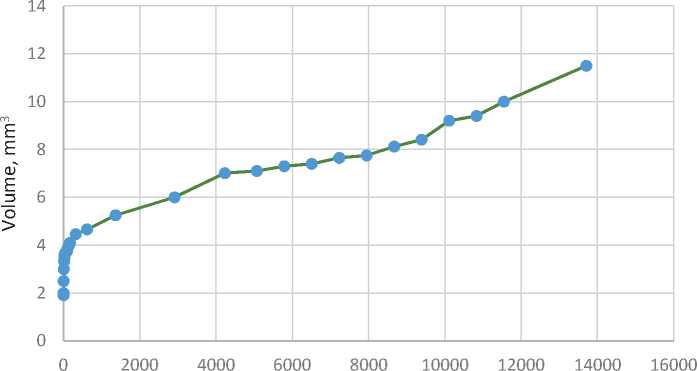
Swelling time, min
Fig. 3. Dynamics of WSP swelling
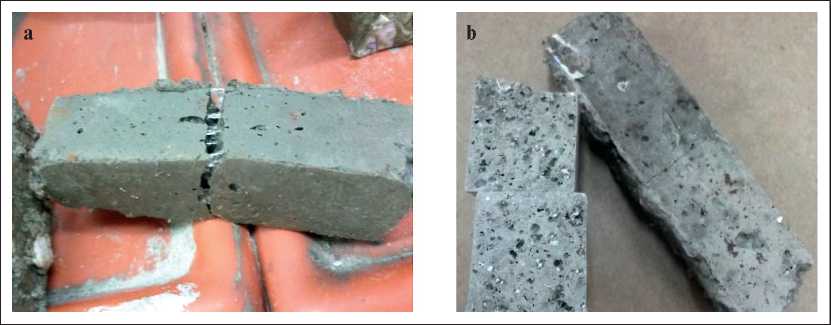
Fig. 4. Samples of cement stone containing WSP (1%):
a) at the age of 2 days in water; b) at the age of 5 days on air
CEMENT AND OTHER BINDERS WITH MINERAL AND ORGANIC ADDITIVES • ЦЕМЕНТНЫЕ И ДРУГИЕ ВЯЖУЩИЕ С МИНЕРАЛЬНЫМИ И ОРГАНИЧЕСКИМИ ДОБАВКАМИ was applied. The sample was not completely broken, and at the same time gel-like fibers can be seen on the crack (Fig. 4a). After 5 days of air-hardening the fibers became dry resulting in the fibers fusion thereafter the gap disappeared (Fig. 4b).
The difficulty in coating of WSP powder turned out to be the main disadvantage. An experiment on WSP granulation with calcium polysulfide coating showed that the layer of coating does not fall evenly, causing clumping of WSP, the granules of which quickly harden. The second layer of silicone lies on the WSP evenly, loosening the particles of WSP in the calcium polysulfide layer. In case of the shell damage, when at the stage of cement mixing vulnerable areas may appear, the mobility of the slurry will be quickly lost even with a plasticizer addition.
Sodium polyacrylate (SP) swells within the first 13 hours, with an increase in volume of up to 175% (Figure 5).
Samples made of cement modified with additive of 1% SP demonstrated a permeability of 0,0012 µm2, which is several times less than the permeability of a stone with an additive of WSP and ten times less than the permeability of a cement stone having no additives.
The strength of the samples for bending at the age of 2 days in water and 5 days on air was equal to 9.9 MPa. SP additive was well integrated into the cement slurry, besides it is hardly noticeable on the cut of the cement stone sample (Figure 6).
The difficulty in coating of SP turned out to be the main disadvantage of this material.
Silica fume is one of the most effective waterproofing mineral supplement (WMS). Swelling of microsilica is not visible, but according to the results of tests the permeability was equal to 0.001 µm2, while the strength of the samples for bending at the age of 2 days was equal to 8.4 MPa. These outcomes are explained by the change in the structure of the stone during the transformation
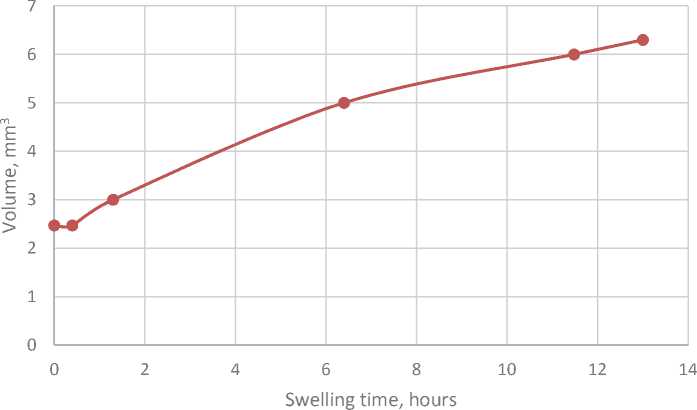
Fig. 5. Dynamics of SP swelling
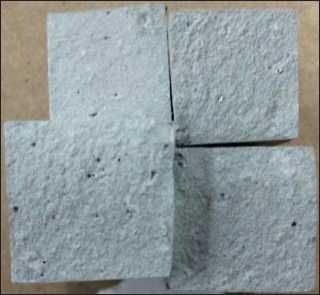
Fig. 6. Samples of cement stone containing SP (1%)
of Ca(OH)2 into calcium hydrosilicates due to the microsilica introduction.
There are some disadvantages of this material such as a slight swelling and difficulty in the coating occurred due to the nano sized particles. In addition, it is necessary to regulate the presence of WMS, since there should be no complete binding of Са(ОН)2 in order to prevent the depassivation of the steel structure.
Water swellable elastomers , WSE, (rubber compounds) demonstrate the ability of the volumetric swelling to vary in the aqueous medium, for fresh water – up to 850%, for formation water – up to 200%. The temperature
CEMENT AND OTHER BINDERS WITH MINERAL AND ORGANIC ADDITIVES • ЦЕМЕНТНЫЕ И ДРУГИЕ ВЯЖУЩИЕ С МИНЕРАЛЬНЫМИ И ОРГАНИЧЕСКИМИ ДОБАВКАМИ
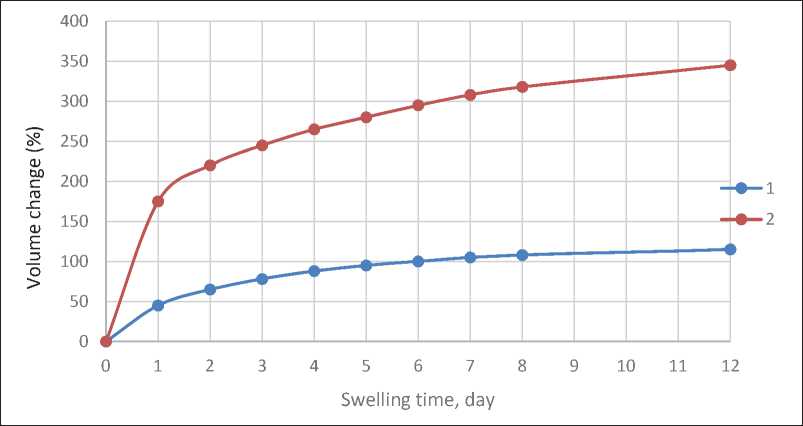
Fig.7-1. Dynamics of swelling of WSE with different concentrations of water absorption modifiers in the formation water of 5% salinity at 90оC
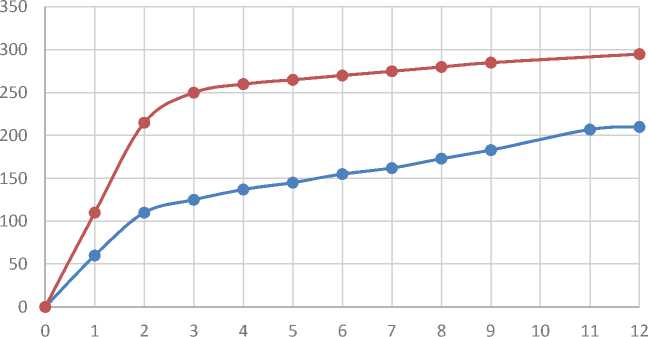
Swelling time, day
Fig. 7-2. Dynamics of WSE swelling in the formation water of 25% salinity: 1 – at 22оС; 2 – at 90оС range of elastomers application is from –30 to +100оС (Figure 7).
Samples made of cement modified with additive of 1% WSE demonstrated a permeability of 0.0014 µm2, while the strength of the samples for bending at the age of 2 days was equal to 7.4 MPa.
There are some disadvantages of this material such as weak adhesion to cement stone and a relatively small degree of swelling.
Figure 8 shows the dynamics of cross-linked copolymer AA swelling. This is a superabsorbent, which absorbs most of the moisture within an hour. It is observed that the smaller the size of the superabsorbent granules, the greater the rate and volume of adsorption.
Samples made of cement modified with additive of crosslinked AA copolymer (1%) demonstrated a permeability of 0.0018 µm2, while the strength of the samples for bending at the age of 2 days was equal to 8.0 MPa.
Samples of superabsorbent are easily covered with a water-soluble polymer complex, which is able to withstand dissolution for 6 hours; they can be easily integrated into the cement system, since the density and size of the particles are commensurate with the particles of cement powder. In a full-scale experiment with the creation
CEMENT AND OTHER BINDERS WITH MINERAL AND ORGANIC ADDITIVES • ЦЕМЕНТНЫЕ И ДРУГИЕ ВЯЖУЩИЕ С МИНЕРАЛЬНЫМИ И ОРГАНИЧЕСКИМИ ДОБАВКАМИ
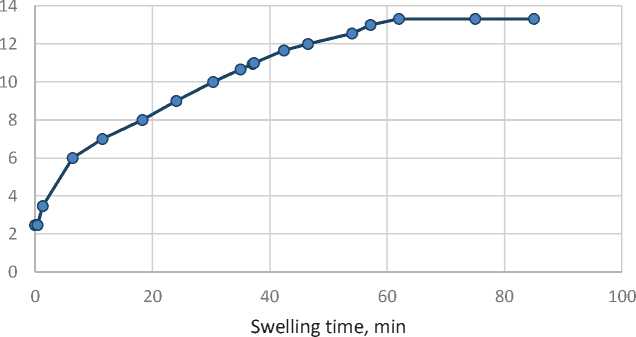
Fig.8. Dynamics of swelling of superabsorbent based on anionic polyacrylamide
of a system of artificial cracks in a sample of cement stone, the water was passed through thus enabling the additive of superabsorbent to swell, filling the entire cavity by the increased volume, and completely blocking the water passing channels.
After conducting a comparative analysis of the water carrying capacity of two samples of cement stone, one of which is made of neat cement, and the other with the addition of superabsorbent when filtering fluid through a system of artificial cracks, it was revealed that at steady state filtration of water, the amount of incoming liquid was equal to the amount of liquid filtered through the cement stone having no additives. With a similar regime of water filtration through the sample with modifying additives, after 5 hours from the moment of the beginning of the water passing through the stone, the process slowed down, after 6 hours the filtration of water completely stopped.
CONCLUSIONS
-
1. A number of reagents combined into a group were considered and analyzed according to two criteria: an increase of the additive in the volume due to the water-
- absorbing mechanism, and the subsequent isolation of water influx by blocking the conducting channels due to a multiple increase in the volume of the modifying additive.
-
2. The additives do not affect the technological properties of cement slurry and cement stone. The density and size of the additive’s particles are commensurate with the particles of cement powder, after being integrated into the cement system are chemically inert to it. Activation of additives results from prolonged and periodic contact with the trigger that is formation water, when triggered providing selective isolation of water conducting channels.
-
3. Application of the process of mechanical activation to increase the rate of modifiers hydration, while controlling the speed of their swelling is achieved by coating the water-absorbing agents in multilayer shells.
-
4. Modifying additive of cross-linked copolymer AA sustains the repeatability of the activation, environmentally safe, affordable and easy to manufacture.
-
5. A comparison of the modifying additives effects on the technological properties of the cement slurry and the resulting cement stone defined the preferability of cross-linked AA copolymer.
CEMENT AND OTHER BINDERS WITH MINERAL AND ORGANIC ADDITIVES • ЦЕМЕНТНЫЕ И ДРУГИЕ ВЯЖУЩИЕ С МИНЕРАЛЬНЫМИ И ОРГАНИЧЕСКИМИ ДОБАВКАМИ
ЭКСПЕРИМЕНТАЛЬНАЯ ЧАСТЬ
Методика экспериментальных исследований
Ф изико-механические свойства модифицирующих добавок, раствора и цементного камня из модифицированного цемента определялись при водоцементном отношении 0,5 на стандартных приборах согласно ГОСТ 1581-96 и ГОСТ 310.1.96. Гранулометрический состав компонентов определялся стандартным методом ситового анализа.
Оценка кинетики набухания проводилась на приборе ПКН-2. Степень набухания образца определялась по ее массовому выражению, %:
M = (m–m0)/m0 • 100, где m – вес набухшего полимера;
m0 – исходный вес полимера.
Проницаемость цементного камня определялась на приборе OFITE MODEL 90 Cement Permeameter.
Предел прочности цементного камня на изгиб и сжатие определялся в возрасте 2-х суток на машине прочности МАТЕСТ.
Поскольку скорость водопоглощения измельченных модифицирующих добавок значительно увеличивается [27], что связано с феноменом механоактивации – приобретением высокой реологической активности при деформации микродефектов, концентрирующих на себе напряжения, для повышения эффективности модифицирующих добавок, они подвергались дополнительному помолу в лабораторном дезинтеграторе при скоростях соударения 150 м/с.
Результаты экспериментальных исследований
Для проверки принципиальной возможности применения полиакриламида (ПАА) в качестве водо-набухаюшего компонента добавки были изготовлены образцы модифицирующих добавок, в которых ядро представлено ПАА, а оболочка – кремнийорганиче-ским полимером.
Оценка кинетики набухания (рис. 1), показала, что добавка начала набухать через 2 часа и далее продолжала в течение 7 часов при максимальном увеличении объема до 150%, по сравнению с исходным объемом добавки.
При определении проницаемости образцов «са-мозалечивающегося» цемента с 1% добавкой при В/Ц = 0,5 образец с модифицирующей добавкой на основе ПАА получил сквозные дефекты и развалился на части.
При тестировании образца на изгиб в возрасте 2-х суток результаты не превысили 3,3 МПа. На рис. 2 представлен снимок образца, на сломе которого визуализируются гелеобразные волокна ПАА, весь образец покрыт слизью, при этом камень обладает неоднородной структурой, замечены средних размеров полости.
Кроме того, из-за размеров порошка ПАА и невозможности его гранулирования возникли сложности при оболачивании ПАА. При этом активное во-допоглощение ПАА требует многослойной оболочки.
Испытания водонабухающего полимера (ВНП) показали, что степень набухания за первые десять часов достигает 144% от первоначального объема, за первые сутки – 174% и за 4 суток – 321%, после этого наступает фаза стабилизации (рис. 3).
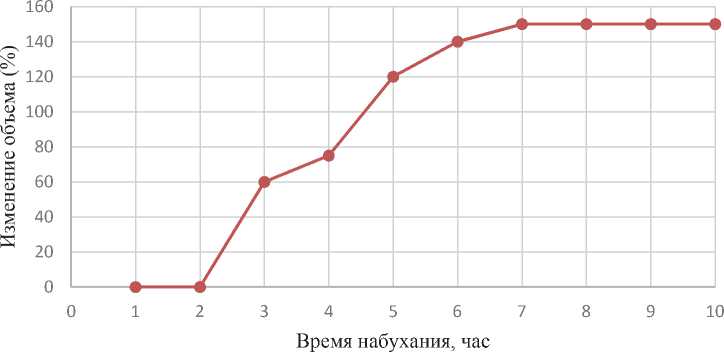
Рис.1. Динамика набухания ПАА
CEMENT AND OTHER BINDERS WITH MINERAL AND ORGANIC ADDITIVES • ЦЕМЕНТНЫЕ И ДРУГИЕ ВЯЖУЩИЕ С МИНЕРАЛЬНЫМИ И ОРГАНИЧЕСКИМИ ДОБАВКАМИ
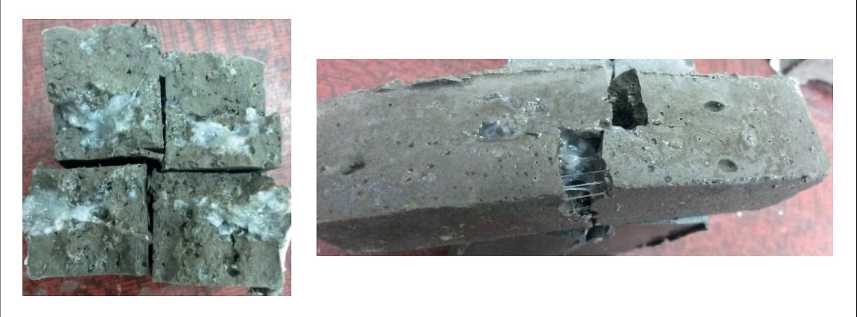
Рис. 2. Образцы камня с добавкой ПАА (1%) после испытания на изгиб
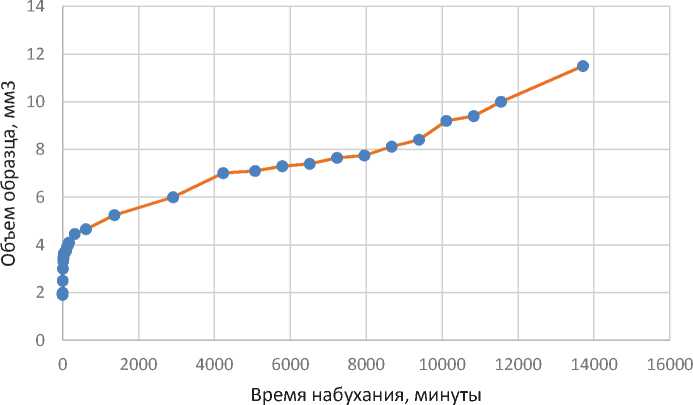
Рис. 3. Динамика набухания ВНП
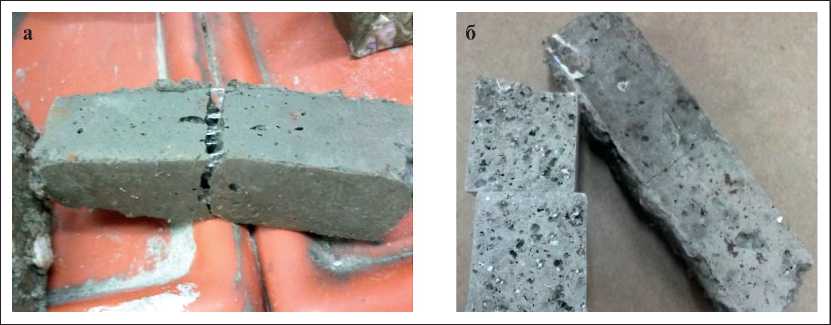
Рис. 4. Образцы с добавкой ВНП (1%): а) 2-е суток в воде; б) 5 суток на воздухе
CEMENT AND OTHER BINDERS WITH MINERAL AND ORGANIC ADDITIVES • ЦЕМЕНТНЫЕ И ДРУГИЕ ВЯЖУЩИЕ С МИНЕРАЛЬНЫМИ И ОРГАНИЧЕСКИМИ ДОБАВКАМИ
Образцы, изготовленные из цемента, модифицированного добавкой ВНП (1%), показали проницаемость, равную 0,002 мкм2.
Прочность образцов в возрасте 2-х суток в воде и 5-ти суток на воздухе составила 7,4 МПа. На рис. 4 видно, что при наложении изгибающей нагрузки образец сломался не до конца, при этом на трещине визуализируются гелевидные волокна (рис. 4а). После 5 суток воздушного твердения волокна высохли, и трещина стянулась (рис. 4б).
Недостатком данного материала также явилась сложность при создании оболочки на ВНП. Эксперимент по грануляции ВНП с получением оболочки из полисульфида кальция показал, что он ложится неоднородно и вызывает комкование ВНП, гранулы которого быстро твердеют. Вторая, кремнийорга-ническая оболочка, ложится на ВНП равномерно, разрыхляя частички ВНП в оболочке полисульфи-
да кальция. В случае повреждения такой оболочки и появления уязвимых участков на этапе затворения цемента, даже при добавлении пластификатора, быстро теряется подвижность раствора.
Набухание полиакрилата натрия (ПАН) проходит в течение 13 часов, с увеличением объема до 175% (рис. 5).
Цементный камень, изготовленный из цемента, модифицированного добавкой ПАН (1%), показал проницаемость, равную 0,0012 мкм2, что в несколько раз меньше проницаемости камня с добавкой ВНП и в десятки раз меньше проницаемости цементного камня без добавок.
Прочность образцов на изгиб в возрасте 2-х суток в воде и 5-ти суток на воздухе составила 9,9 МПа. Добавка ПАН хорошо интегрировалась в цементный раствор и мало заметна на срезе образца цементного камня (рис. 6).
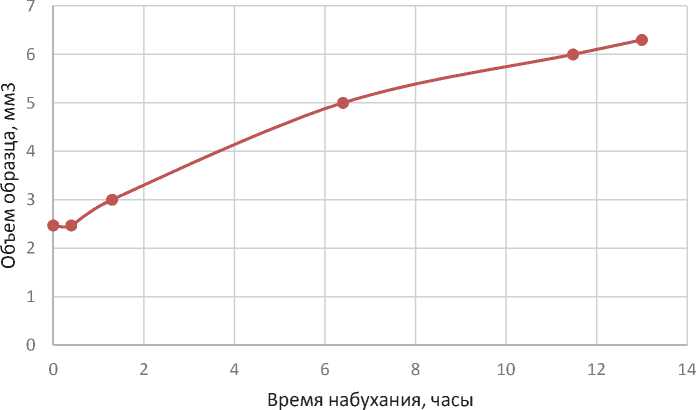
Рис. 5. Динамика набухания ПАН
Рис. 6. Образцы с добавкой ПАН (1%)
Недостатком данного материала явилась сложность при оболачивании ПАН.
Гидроизолирующие минеральные добавки были представлены микрокремнеземом. Видимого набухания микрокремнезема не произошло, однако проницаемость образца цементного камня составила 0,001 мкм2, а прочность на изгиб в возрасте 2-х суток – 8,4 МПа. Эти результаты объясняются изменением структуры камня при трансформации Са(ОН)2 в гидросиликаты кальция за счет введенного микрокремнезема.
CEMENT AND OTHER BINDERS WITH MINERAL AND ORGANIC ADDITIVES • ЦЕМЕНТНЫЕ И ДРУГИЕ ВЯЖУЩИЕ С МИНЕРАЛЬНЫМИ И ОРГАНИЧЕСКИМИ ДОБАВКАМИ
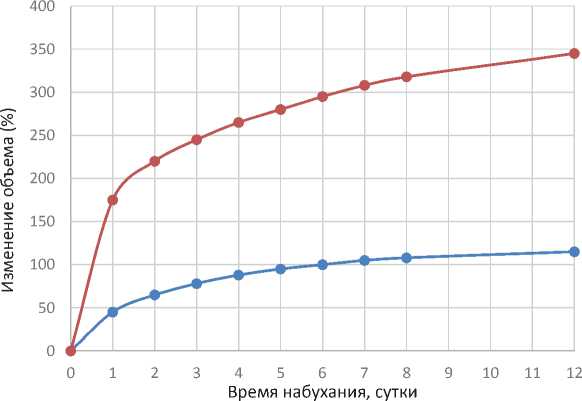
—•— 1
—e— 2
Рис. 7-1. Динамика набухания образцов резиновых смесей, отличающихся концентрацией модификаторов водопоглощения в пластовой воде с минерализацией 5% при 90оС
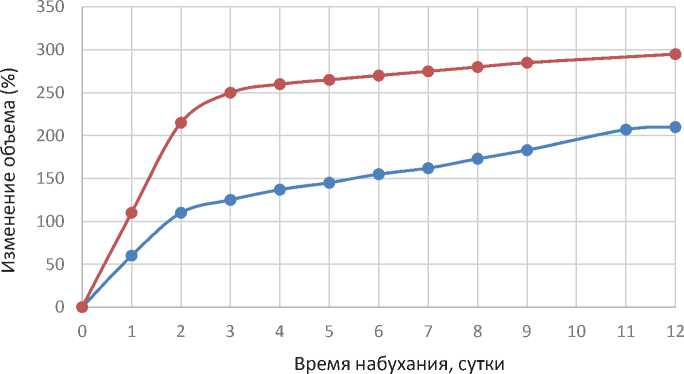
Рис.7-2. Динамика набухания образцов резиновой смеси в пластовой воде с минерализацией 25%: 1 – при 22оС; 2 – при 90оС
Недостатками данного материала явились небольшое набухание и сложности при его оболачи-вании в связи с наноразмерами. Кроме того, необходимо регламентировать присутствие ГМД, так как не должно происходить полного связывания Са(ОН)2 и нарушения условий пассивации обсадной колонны.
Водонабухающие эластомеры (резиновые смеси) показали, что величина их объемного набухания в водной среде может варьироваться: для пресной воды – до 850%, для пластовой воды – до 200%. Тем- пературный диапазон применения эластомеров – от –30 до +100оС (рис. 7).
Образцы с добавкой резиновой смеси показали проницаемость, равную 0,0014 мкм2, и прочность на изгиб в возрасте 2-х суток – 7,4 МПа.
Главными недостатками водонабухающих эластомеров (резиновых смесей) явились слабая адгезия с цементным камнем и сравнительно небольшая степень набухания.
На рис. 8 представлена динамика набухания сшитого сополимера АА , суперабсорбента, который
CEMENT AND OTHER BINDERS WITH MINERAL AND ORGANIC ADDITIVES • ЦЕМЕНТНЫЕ И ДРУГИЕ ВЯЖУЩИЕ С МИНЕРАЛЬНЫМИ И ОРГАНИЧЕСКИМИ ДОБАВКАМИ
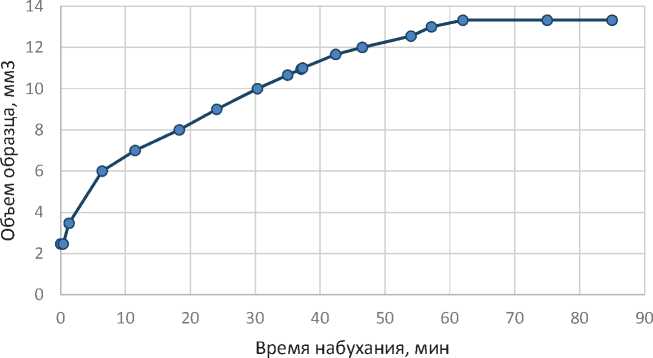
Рис. 8. Динамика набухания суперабсорбента на основе анионного поликриламида
абсорбирует большую часть влаги в течение часа. Замечено, что чем меньше размер гранул суперабсорбента, тем больше скорость и объем адсорбции.
Образцы с добавкой сшитого сополимера АА (1%) показали проницаемость, равную 0,0018 мкм2, а предел прочности на изгиб в возрасте 2-х суток составил 8,0 МПа.
Образцы суперабсорбента легко покрываются водорастворимым полимерным комплексом, который способен выдержать растворение в течение 6 часов, и не вызывают сложностей при его интеграции в цементную систему, так как плотность и размер частиц соразмерны частицам цементного порошка. На натурном эксперименте с получением системы искусственных трещин при поступлении пластовой воды добавка суперабсорбента начала набухать, заполнив весь объем полости, полностью заблокировав водопроводящие каналы.
Проведя сравнительный анализ водопропускной способности двух образцов цементного камня, один из которых выполнен из бездобавочного цемента, а другой – с добавкой суперабсорбента при фильтрации жидкости через систему искусственных трещин, было замечено, что при установившемся режиме фильтрации количество входящей жидкости было равно количеству жидкости, профильтрованной через цементный камень, не содержащий добавки. При аналогичном режиме фильтрации воды через образец с модифицирующей добавкой по истечении 5 часов с момента начала пропускания воды процесс замедлился, через 6 часов фильтрация воды полностью прекратилась.
ВЫВОДЫ
-
1. Рассмотрен и проанализирован ряд реагентов, объединенных в общую группу по двум признакам: увеличение добавки в объеме за счет водопоглотительного механизма и последующая изоляция водопритока блокированием проводящих каналов в результате кратного увеличения объема модифицирующей добавки.
-
2. Отсутствие влияния модифицирующей добавки на технологические свойства тампонажного раствора и цементного камня. Плотность и вес частиц добавки соразмерны частицам цементного порошка, после интеграции в цементную систему химически инертны к ней. Активация добавок происходит в результате длительного и периодического контакта с триггером, которым является пластовая вода, обеспечивая селективную изоляцию водопроводящих каналов.
-
3. Применение технологического приема механоактивации для увеличения скорости гидратации модифицирующих добавок и регулирование скорости их набухания достигается покрытием водопоглощающего реагента в многослойные оболочки.
-
4. Модифицирующая добавка из сшитого сополимера АА обладает многократностью действия, экологически безопасна, доступна и несложна в изготовлении.
-
5. Сравнение действий модифицирующих добавок на технологические свойства цементного раствора и получаемого цементного камня показало преимущества сшитого сополимера АА.
CEMENT AND OTHER BINDERS WITH MINERAL AND ORGANIC ADDITIVES • ЦЕМЕНТНЫЕ И ДРУГИЕ ВЯЖУЩИЕ С МИНЕРАЛЬНЫМИ И ОРГАНИЧЕСКИМИ ДОБАВКАМИ

